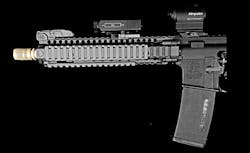IMAGE (UPPER):An AR-15 pistol is equipped with an Auxetic muzzle break fabricated using a 3D printing process. (Image credit: Sintercore)
Grand Rapids, MI--Michigan-based Sintercore is billing its Auxetik (pronounced Aug-ZETIK) as the first commercial three-dimensional 3D printed firearm muzzle brake. Made of Inconel alloy using a laser additive manufacturing (LAM) process, the Auxetik is designed to tame the recoil and muzzle rise of AR-15 pistols chambered for .223 caliber (5.56 x 45mm) NATO rounds.
The AR-15 is the semi-automatic civilian version of the military M-16, which is used by over 80 countries. While the AR-15 is used for target shooting and hunting, it also occupies an unusual position in the gun world by account of its modular design that allows for extensive customization. When the stock of an AR-15 is removed and there is only one grip, it is considered under US ATF (Alcohol, Tobacco, and Firearms) regulations to be a pistol. The AR-15 pistol modification does not result in the most practical firearm. Such a pistol has stronger recoil and muzzle flip than do the rifle versions, so adding a muzzle brake to direct the propellant gases emerging from the barrel upwards and backwards help to minimize these effects, and make the pistol more controllable.
Sintercore's muzzle brake includes design elements that would be difficult and expensive to create using conventional machining methods, including being fabricated from an Inconel alloy, so it has chosen to use 3D printing via the direct metal laser sintering (DMLS) process. In the DMLS process, an object being "grown" is covered with a very thin layer of metal power, which is then scanned by a laser so it melts, along with a thin layer of the underlying growth surface, thereby forming a full density solid object.
DMLS is capable of great accuracy, with thickness of the growth layers being as small as 20 microns (0.0008 inch), and tolerances perpendicular to the growth direction of about 100 microns (0.004 inch). It is a slow process at present, adding about 2 cubic millimeters per second (about 7 cc/hr) when growing an object of Inconel alloy, but this may improve with additional developmental work.
Using this process, the Inconel has about 70% of the strength of properly heat-treated Inconel. The lower strength is caused by the rapid solidification of the alloy after the laser passes over. Once the DMLS Inconel parts are subjected to a standard heat-treatment, they display strength and ductility nearly identical to a more conventionally machined component.
The Auxetic is available at a suggested retail price of U.S. $300. A conventional muzzle brake made of softer materials costs perhaps $80, while a competing upper-end muzzle brake made of Inconel is available for about $400. The word on the web is that Inconel is overkill for the functional purpose, but it looks and performs well. The real significance, though, is that Sintercore has taken a step toward a new method of designing and fabricating firearms.
IMAGE (LOWER):Sintercore's Auxetic Inconel muzzle break is shown; the central image is a target's eye view of the device, and the other images are rotations from that position. (Image credit: Sintercore)
SOURCE: Sintercore via Gizmag; http://www.gizmag.com/sintercore-auxetik-3d-printed-muzzle-brake-inconel/28489/
